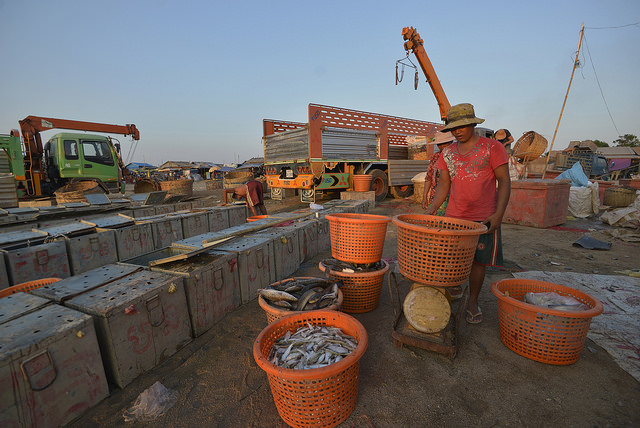
Local workers loading fresh catch to be transported to the city market at Chhnoc Trou pier, Kampong Chhnang province, Cambodia. Photo by Sylyvann Borei/World Fish, taken on 7 April 2014. Licensed under CC BY-NC-ND 2.0.
Cambodia has abundant and productive fisheries. Fish is a traditional staple in the Cambodian diet and vital to nutrition and food security. The country’s inland fisheries form part of the Mekong River system, the biggest inland fishery in the world yielding around 2.1 million tonnes of fish each year.1 Cambodian fishery resources are unparalleled on a global scale, too. The country holds two world records: the highest catch of inland fisheries per capita and the highest consumption of freshwater fish per capita.2 According to a 2015 WorldFish report, Cambodians are among the highest consumers of freshwater fish in the world, with annual per capita fish consumption estimated at 52.4 kg.3
Fishing industry on the Tonle Sap Lake employs about 2 million people in capture, culture, processing, trade and transport.4 The Cambodian Fisheries Administration estimated that the total fish catch landed from the Lake in 2012 was about 500,000 tonnes.5
The Ministry of Agriculture, Forestry and Fisheries (MAFF) reports that freshwater fisheries production fluctuated from 2012 to 2014. Freshwater fish captures peaked at 505,005 tonnes in 2013, and then dropped by around 4 percent in 2014. In contrast, marine fisheries and aquaculture have made stronger growth. Marine fisheries went up from 99,000 tonnes in 2012 to 120,250 tonnes in 2014, representing an increase of 17 percent. Aquaculture production rose from 74,000 tonnes in 2012 to 120,055 tonnes in 2014, an increase of 38 percent.6
Speaking at the National Fish Day in July 2015, the Minister of Agriculture, Forestry and Fisheries Ouk Rabun highlighted the remarkable growth of aquaculture production, with 65,000 households involved in fish farming, up from 61,000 in 2013. The minister also noted the importance of freshwater fish production for family consumption as well as for local and export markets.7
Last updated: 30 September 2015
Related to fisheries production
- Agriculture and fishing
- Fishing policy and administration
- Fishing, fisheries and aquaculture
- Community fisheries
References
- 1. Baran, E., Chheng Phen, Ly Vuthy, Nasielski, J., Saray Samadee, Touch Bunthang, Tress, J., Kaing Khim, Tan Sokhom (2014). Chapter 4 (p. 37-48) in: Atlas of Cambodia: Maps on Socio-Economic Development and Environment. Save Cambodia’s Wildlife, Phnom Penh, Cambodia. 178 pp. http://pubs.iclarm.net/resource_centre/WF-3709.pdf.
- 2. Ibid.
- 3. Oliver Joffre, Yumiko Kura, Jharendu Pant and Nam So. 2010. “Aquaculture for the Poor in Cambodia – Lessons Learned.” Phnom Penh: WorldFish Centre. Accessed 22 June 2015. http://pubs.iclarm.net/resource_centre/WF_2769.pdf.
- 4. Hap Navy, Un Sophea, Josh Nasielski and Eric Baran. 2012, “Quantitative Values of Fish in Relation to other Natural and Agricultural Resources.” http://ifredi-cambodia.org/wp-content/uploads/2004/01/VAL04%20MARKETS_Literature_review.pdf.
- 5. “Concern Over Tonle Sap Catch.” 2012. Radio Free Asia, 28 November. Accessed 16 August 2014. http://www.rfa.org/english/news/cambodia/tonle-sap-11282012191709.html.
- 6. Ministry of Agriculture, Forestry and Fisheries. 2015. Annual Report 2014 and Actions Plan for 2015. Phnom Penh: MAFF: p. 20. Accessed 10 June 2015, https://server2.maff.gov.kh/parse/files/myAppId5hD7ypUYw61sTqML/96998f6f93549c6389810059579f0083_1503018702.pdf
- 7. “Fisheries Production Rises 2.4 Percent in Latest Year.” Cambodia Herald, 3 July 2015. Accessed 20 July 2015, http://www.thecambodiaherald.com/cambodia/fisheries-production-rises-24-percent-in-latest-year-8733.

